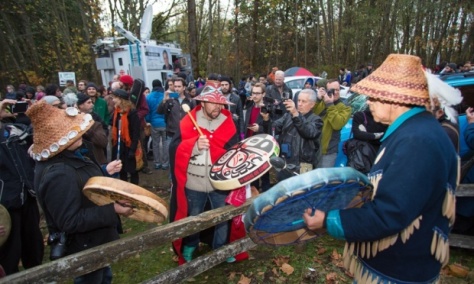
Harper government organized private meetings between oil firms and Indigenous chiefs to try and gain support for oil and gas pipelines and other investments located on their lands, documents reveal
The Harper government is trying to win support for its pipelines and resource agenda by pushing First Nations to sideline their aboriginal rights in exchange for business opportunities, documents reveal.
The news that Canada’s Ministry of Aboriginal Affairs is working to this end by collaborating with the Assembly of First Nations (AFN) is sparking strong criticism from grassroots Indigenous people.
Funded by the federal government, the Working Group on Natural Resource Development held private meetings in Toronto and Edmonton in the fall of 2014 that were attended by several invited Chiefs and representatives from Enbridge, Syncrude and other oil corporations, as well as mining companies and business lobby groups.
In one email, a government official writes that it was “widely agreed” at the meetings that “unlocking resource development projects is squarely in the national interest,” a suggestion that will be contested by many First Nations involved in mounting protests against pipelines and other industrial projects around the country.
It was “noted repeatedly” that “we can no longer afford the investment uncertainty created by issues around Aboriginal participation,” the official writes. The transcripts of the meetings were redacted in the documents, which were obtained through access-to-information.
The documents cite $600 billion of investment that the Harper government hopes will flow in the next decade into mining, forestry, gas and oil projects. As of March 2013, 94 of 105 projects under federal review were “located on reserve, within an historic treaty area, or in a settled or unsettled claims area”.
In response to these pressures, considerations for the groups’ mandate include “reducing uncertainty and investment risk” and “advancing business-to-business partnerships rather than through a rights-based agenda.”
The federal government has been criticized for trying to minimize or ignore the land rights of First Nations, including refusing to implement the United Nations Declaration on the Rights of Indigenous Peoples. It has been doing extensive risk evaluations, increasingly worried that the growing power of indigenous rights could hamper its aggressive resource extraction plans.
One document suggests that “case studies have shown that separating rights-based agenda (politics) from economic development (business) is key to wealth generation in First Nations communities.”
The case studies cited from “expert bodies” include a Fraser Institute report entitled “Opportunities for First Nations Prosperity Through Oil and Gas Development.” The right-wing think tank has been heavily funded by the American Koch brothers, who are one of the largest owners, purchasers and refiners of the Alberta tar sands.
Also referenced is a report by envoy Douglas Eyford, whose appointment by Harper in late 2013 was seen as strategic shift to increasingly woo First Nations in the path of planned pipelines in British Columbia with an economic stake in resource plans. Eyford warned that the federal government’s failure to build good relationships with First Nations had set back the chances for their energy projects.
“Opposition to these projects by aboriginal groups may doom the development of oil, and natural gas pipelines and related infrastructure because neither industry nor our trading partners are prepared to idly stand by to wait out the results of judicial proceedings that can take a generation to complete,” Eyford said in a speech last year.
“The Harper government and resource corporations are keenly aware that Indigenous rights movements are standing in the way of their polluting, destructive projects,” said Clayton Thomas Mueller, Indigenous Extreme EnergyCampaigner with 350.org. “Harper is desperately trying to manipulate the Assembly of First Nations and some of our Chiefs into sacrificing our rights and our lands at the altar of profit. But respect for our rights must be a basis for economic decision-making – indeed our rights offer a pathway to a more sustainable economic order for everyone in this country.”
The group was launched in December 2013, its creation among the pledges made by Prime Minister Harper at a January 2013 meeting with former National Chief Shawn Atleo, a meeting triggered by Theresa Spence’s hunger strike and the Idle No More movement.
It has two representatives from the Ministry of Aboriginal Affairs and two from the Assembly of First Nations, an organization which has been accused of being out of touch with grassroots Indigenous concerns. According to the documents, the representatives discussed renaming the group to “downplay” the connection between the Assembly of First Nations and the government and to make clear that it operates at “arms-length.”
The documents acknowledge that Indigenous community members are increasingly resisting those Chiefs who “try to establish and advance a “business to business” relationship with industry proponents.”
Included are detailed charts of economic opportunities that some First Nations located near oil and mining operations have been able to access.
The documents say that the group may propose that Canada’s largest corporate lobby, the Canadian Council of Chief Executives, be “engaged to champion a new approach including through formal statements at First Minister’s Meetings or major political events.”
Other suggestions include a “centre of expertise on resource development” and a national roundtable, emphasizing the need to get more aboriginal organizations involved.
The group is releasing a final report on Tuesday with recommendations to the federal government and the AFN.
The Ministry of Aboriginal Affairs was unable to respond to a request for comment.



































 Adbusters has crafted a powerful and controversial 30-second TV spot, based on an actual incident, to spark a deeper nationwide conversation about what it means to be Canadian. Our strategy over the next few weeks is to give millions of Canadians an honest, unflinching wake up call.
Adbusters has crafted a powerful and controversial 30-second TV spot, based on an actual incident, to spark a deeper nationwide conversation about what it means to be Canadian. Our strategy over the next few weeks is to give millions of Canadians an honest, unflinching wake up call.

























